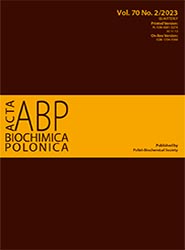Effect of 6-hydroxydopamine increase the glutathione level in SH-SY5Y human neuroblastoma cells
Abstract
Treatment of human neuroblastoma SH-SY5Y cells with a catecholaminergic neurotoxin, 6-hydroxydopamine (6-OHDA) is an acknowledged in vitro experimental model of Parkinson disease (PD). A decrease in the glutathione content occurs in PD. Higher concentrations of 6-OHDA lowered the glutathione level in SH-SY5Y cells, nonetheless, we and other authors found a considerable increase in these cells’ glutathione content after 24 h treatment with 60 μM 6-OHDA. A synthetic antioxidant, 4-aminotetramethylpiperidine-1-oxyl (4-AT) exerted a similar effect. The aim of the present study was to explain this surprising effect by monitoring the time course of changes in the levels of reduced (GSH) and oxidized glutathione (GSSG), total antioxidant activity (TAC) of human neuroblastoma cell SH-SY5Y extracts as well as the level of reactive oxygen species and activities of enzymes of glutathione metabolism after treatment of the cells with 60 µM 6-OHDA and/or 4-AT for 30 min – 24 h. A transient decrease in the level of GSH and TAC of cell extracts, increase in the level of GSSG, and decrease in the activities of glutathione peroxidase, glutathione reductase, glutathione S-transferase and γ-glutamyl-cysteine ligase activities were found followed by normalization or overshoot of the GSH level, TAC and enzyme activities. Increased activity of γ-glutamyl-cysteine ligase activity starting after 4-6 h was responsible for the elevation of the level of GSH and TAC in cells treated with 6-OHDA, 4-AT, and both compounds. The 6-OHDA-induced increase in the GSH content is a result of an overcompensatory response. The antioxidant 4-AT may be useful for the induction of an increase in the level of GSH in neural cells, without the negative effect of 6-OHDA.
Acta Biochimica Polonica is an OpenAccess quarterly and publishes four issues a year. All contents are distributed under the Creative Commons Attribution-ShareAlike 4.0 International (CC BY 4.0) license. Everybody may use the content following terms: Attribution — You must give appropriate credit, provide a link to the license, and indicate if changes were made. You may do so in any reasonable manner, but not in any way that suggests the licensor endorses you or your use.
Copyright for all published papers © stays with the authors.
Copyright for the journal: © Polish Biochemical Society.


